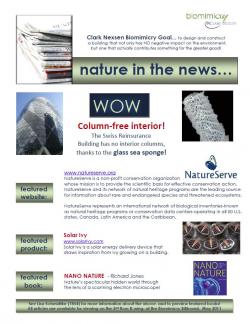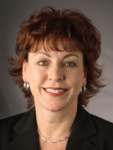An Interview with a Certified Biomimicry Professional (Lisa Schmidtke)
Lisa Schmidtke discovered the BID Community site late in 2010 while searching for resources and looking for help in establishing the practice of biomimicry at Clark Nexsen. She is part of the first cohort of the Biomimicry Institute's Two-Year Certificate program, now called the Biomimicry Professional Certification Program. Lisa has been actively involved in the BID Community initiatives Turning Ideas into Reality and Making a Living with BID.
Norbert: How did you get started in biomimicry?
Lisa: I met Janine Benyus in 2003 and was inspired by the potential of biomimicry to make a difference. Aside from the fact that biomimicry just “makes sense”, there is really nothing not to like about it - it was a way for me to tie together my love of design, problem-solving and nature. What a perfect job this could be for me! After intensive reading about the field, I decided to enroll in the very first Two-Year Certificate program and graduated in April 2010.
Norbert: Where have you taken biomimicry since then?
Lisa: Throughout the program I strategically “organized” and collected everything I could get my hands on about biomimicry, formulating mental plans of how I was going to intertwine this into my career and the future of my company. There is no roadmap to “practicing” biomimicry, but by the end of the program (big kudos to the Biomimicry Institute and the interdisciplinary approach of the Program), I had a four page proposal for Clark Nexsen that outlined how biomimicry could be a useful tool to help incorporate deeper sustainability practices for the firm.
Lisa: Starting from scratch , helping a large firm learn a whole new way of approaching design, really starting with the ABC’s and 1-2-3's! Biomimicry can be very conceptual: it can be difficult to find real-life examples relevant to a specific discipline or industry. What is the business model for developing and deploying biomimetic tools and processes in architecture, MEP (Mechanical, Electrical, Plumbing) and master planning? Bridging the gap between inspiration and tangible design solutions can also be challenging, so I am always thinking “the simpler the better”: develop tools that fall gracefully into a budget- and schedule-ridden industry that cannot afford to keep reinventing the process.
, helping a large firm learn a whole new way of approaching design, really starting with the ABC’s and 1-2-3's! Biomimicry can be very conceptual: it can be difficult to find real-life examples relevant to a specific discipline or industry. What is the business model for developing and deploying biomimetic tools and processes in architecture, MEP (Mechanical, Electrical, Plumbing) and master planning? Bridging the gap between inspiration and tangible design solutions can also be challenging, so I am always thinking “the simpler the better”: develop tools that fall gracefully into a budget- and schedule-ridden industry that cannot afford to keep reinventing the process.
Lisa: In addition to their evaluation role, I have found the Life’s Principles to be a useful front-end tool, encouraging a greater focus on sustainability and helping channel creativity along paths that are more likely to be productive. My thesis project for Cuyahoga County in Ohio explored “Incorporating Life’s Principles into Policy”. The process my team went through to fulfill that year-long project is a “recipe” that I can now use to approach any kind of client!
Norbert: What are some of the insights you have developed?
Lisa: It is critical to discuss and infuse biomimicry through the use of comfortable and meaningful language, goals and challenges. Rather than trying to invent something that is brand new, an incremental approach can deliver benefits faster and help integrate biomimetic thinking into existing practice.
Norbert: Where are you going from here?
 Lisa: I have been charged by Clark Nexsen to roll out simple tools for all 500 staff. I continue to train staff through Continuing Education Units, host a regular BioBrainstorming meeting in the office and publish a monthly Biomimicry Billboard (the first page of the May issue is shown at the right). I am also working on the design of an Eco-Charette for the firm; organizing the information I have collected on biomimicry into a very cool database; building a library of biological and technological examples that exemplify Life’s Principles; and helping architects, engineers, and planners identify functions and challenges which can then be related to biological principles.
Lisa: I have been charged by Clark Nexsen to roll out simple tools for all 500 staff. I continue to train staff through Continuing Education Units, host a regular BioBrainstorming meeting in the office and publish a monthly Biomimicry Billboard (the first page of the May issue is shown at the right). I am also working on the design of an Eco-Charette for the firm; organizing the information I have collected on biomimicry into a very cool database; building a library of biological and technological examples that exemplify Life’s Principles; and helping architects, engineers, and planners identify functions and challenges which can then be related to biological principles.
Norbert: How can the BID Community help you achieve your goals?
Lisa: I am hoping to find kindred spirits (local “others” interested in biomimicry to share and collaborate with) and to be exposed to fresh topics in order to stay current with emerging bio-inspired products and ideas!
Norbert: Lisa, on behalf of the BID Community, thanks for taking the time to share your experiences!
Image Credits:
- On Air: © frank peters - Fotolia.com
- biomimicry@ClarkNexsen: Clark Nexsen
- Biomimicry Bulletin: Lisa Schmidtke

Lisa Schmidtke works as a Certified Biomimicry Professional at Clark Nexsen, an architecture and engineering firm in Norfolk (Virginia), and has been given the mission to integrate biomimicry into the firm’s practice. She studied architecture and interior design as an undergrad and is 1 of 15 graduates of the first Two-Year Certificate Program offered by the Biomimicry Institute.

